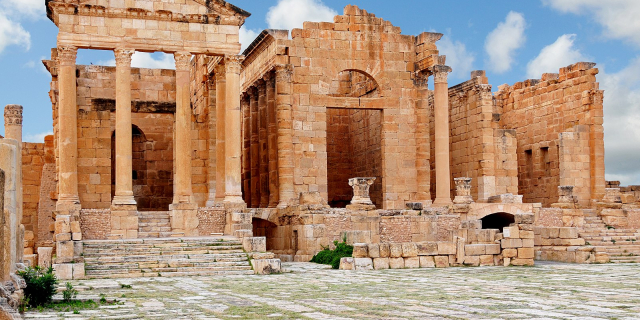رباط سوسة
( Ribat of Sousse )Ribat of Sousse (Arabic: رباط سوسة) is a ribat in the city of Sousse, Tunisia. Although scholars differ on the chronology of its original construction, it was most likely founded in the 8th century and reconstructed or completed in its current form during the early 9th century, under the Aghlabid dynasty. Although a large number of ribats were built in the region during that period, the Ribat of Sousse is by far the best-preserved.
The Ribat of Sousse was founded during the 8th century,[1] or late 8th century,[2][3] during the tenure of the Abbasid governor Yazid ibn Hatim al-Muhallabi (d. 787).[2] There is also evidence that the site of the ribat was formerly occupied in Classical antiquity, reflecting the fact that many ribats in Tunisia were built over the remains of more ancient fortifications.[4]
 The Aghlabid inscription on the tower (uncoloured photo)
The Aghlabid inscription on the tower (uncoloured photo)In the year 800 the Abbasid Caliph Harun al-Rashid granted the governorship of Ifriqiya (roughly modern-day Tunisia) to Ibrahim ibn al-Aghlab, who founded the Aghlabid dynasty that ruled the region for the next century, nominally on behalf of the Abbasids. This was period in which the construction of ribats proliferated,[5] and they were constructed at regular intervals along Ifriqiya's coastline, permitting signals to be sent rapidly between them.[6]: 4 An inscription carved on a marble plaque over the doorway of the ribat's cylindrical tower records the name of the Aghlabid emir Ziyadat Allah I and the year 821.[2] It also names Masrur al-Khadim, a freed slave and Ziyadat Allah's mawla, as responsible for the construction.[6]: 73, 195 This is the oldest surviving Islamic-era monumental inscription in Tunisia.[2] The full Arabic inscription and its translation reads:[7]
In the name of God, the Kind, the Merciful. God’s Blessing. This is what the Emir Ziyādat Allāh ibn Ibrāhīm has ordered, may God prolong his life!... by the hands of Masrūr al-Khūdim [the servant], his emancipated slave, in the year 206 [821 AD]. O God, lead us down into a blessed home. You are the best of leaders.
Some scholars have interpreted the date in this inscription as the year of the ribat's original foundation.[2] Other scholars, such as Alexandre Lézine and Jonathan Bloom, interpret this date as the year when the tower was added to the existing ribat.[8][2] Georges Marçais cited the year 821 as the date of the tower's construction and the completion of the ribat in its current form.[5] Mourad Rammah states that the ribat was almost certainly founded in the 8th century but was completely reconstructed by Ziyadat Allah I in 821.[1] Scholar Sibylle Mazot states that soil analysis has demonstrated that the ribat's foundation is indeed older than 821 and dates back to the 8th century, so that the year 821 signifies the date of a reconstruction.[4]
During the restoration, two floors, a basement, and battlements were added, as well as thirty rooms for guards to live complete with bathroom and toilet. A mosque was also established on the terrace and used by the citizens of Sousse especially during the Eid al-Fitr or Eid al-Adha. It is considered the first mosque built in the city, older even than the Bou Ftata Mosque and the Great Mosque of Sousse. The ribat is also equipped with a water basin that collects rainwater for the use of drinking and washing. The basin was first built by Ibrahim ibn al-Aghlab and was expanded later by Ziyadat Allah.[9][better source needed][10][dead link] After the Byzantine city of Melite (modern Mdina on Malta) was captured by the Aghlabids in 870, marble and columns plundered from its churches was used to build the Ribat.[11][dubious ]
The north and east wings of the ribat's interior were rebuilt or restored in 1722.[1] Other than this, the building has mostly retained its original aspect.[12] In 1988 it was inscribed, along with the Medina of Sousse, as a UNESCO World Heritage Site.[13]






























Add new comment